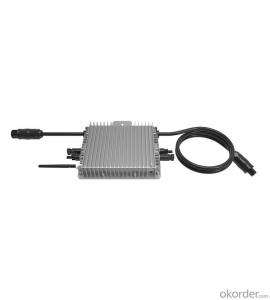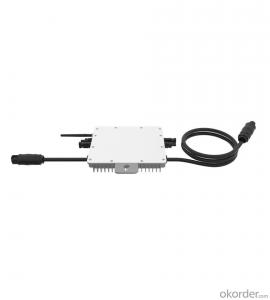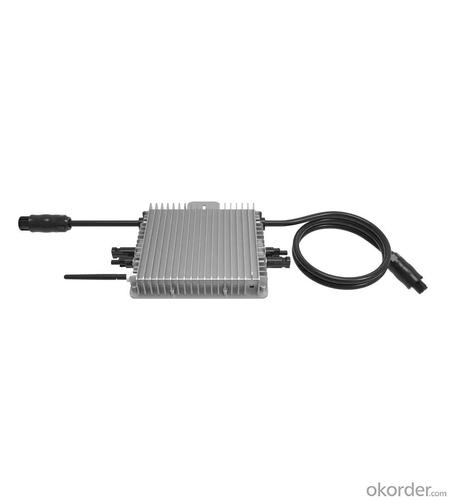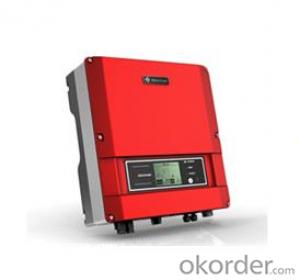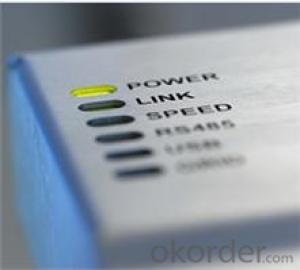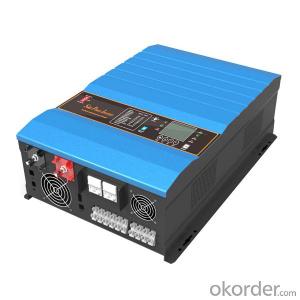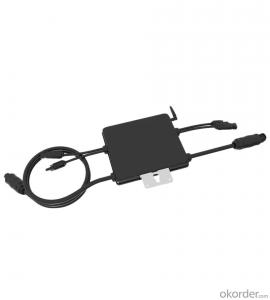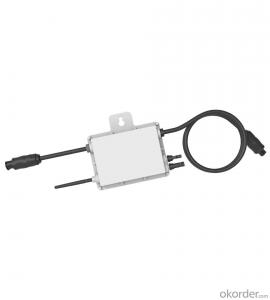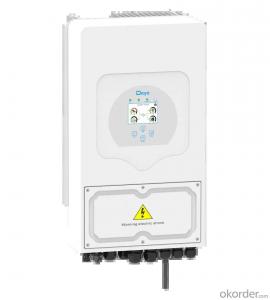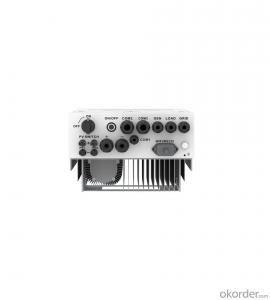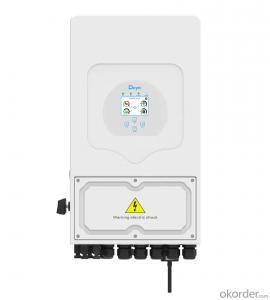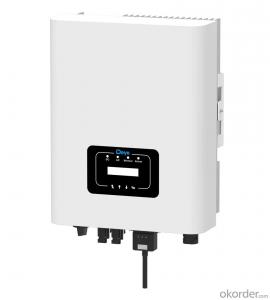2000 Watt Solar Inverter Sun600/800/1000G3-EU-230 600-1000W Single Phase 2 MPPT Micro-Inverter Rapid Shutdown
- Loading Port:
- Ningbo
- Payment Terms:
- TT OR LC
- Min Order Qty:
- 100 pc
- Supply Capability:
- 5000 pc/month
OKorder Service Pledge
OKorder Financial Service
You Might Also Like
Specification
The SUN 600/800/1000G3 is a new generation grid-tied microinverter with intelligent networking and monitoring systems to ensure maximum efficiency. The SUN 600/800/1000G3 is optimized to accommodate today’s high output PV modules effectively with up to 500W output and dual MPPT. Also, it supports rapid shutdown application, ensuing your investment safe.
Module level monitoring, safer and smarter
Max. DC input current 12.5A, adapt to 500W PV module
Rapid shutdown function
IP67 protection degree,10 years warranty
PLC, Zigbee or WIFI communication
2 MPP trackers, module level monitoring
| Technical Data | ||||||||
| Model | SUN600G3-US-220 | SUN800G3-US-220 | SUN1000G3-US-220 | |||||
| Input Data (DC) | ||||||||
| Recommended input Power (STC) | 210~400W (2 Pieces) | 210~600W (2 Pieces) | 210~600W (2 Pieces) | |||||
| Maximum input DC Voltage | 60V | |||||||
| MPPT Voltage Range | 25~55V | |||||||
| Full Load DC Voltage Range (V) | 24.5~55V | 33~55V | 40~55V | |||||
| Max. DC Short Circuit Current | 2×19.5A | |||||||
| Max. input Current | 2×13A | |||||||
| No.of MPP Trackers | 2 | |||||||
| No.of Strings per MPP Tracker | 1 | |||||||
| Output Data (AC) | ||||||||
| Rated output Power | 600W | 800W | 1000W | |||||
| Rated output Current | 2.7A | 2.6A | 3.6A | 3.5A | 4.5A | 4.4A | ||
| Nominal Voltage / Range (this may vary with grid standards) | 220V/ 0.85Un-1.1Un | 230V/ 0.85Un-1.1Un | 220V/ 0.85Un-1.1Un | 230V/ 0.85Un-1.1Un | 220V/ 0.85Un-1.1Un | 230V/ 0.85Un-1.1Un | ||
| Nominal Frequency / Range | 50 / 60Hz | |||||||
| Extended Frequency / Range | 45~55Hz / 55~65Hz | |||||||
| Power Factor | >0.99 | |||||||
| Maximum units per branch | 8 | 6 | 5 | |||||
| Efficiency | ||||||||
| CEC Weighted Efficiency | 95% | |||||||
| Peak Inverter Efficiency | 96.5% | |||||||
| Static MPPT Efficiency | 99% | |||||||
| Night Time Power Consumption | 50mW | |||||||
| Mechanical Data | ||||||||
| Ambient Temperature Range | -40~65℃ | |||||||
| Size (mm) | 212W×230H×40D (Without mounting bracket and cable) | |||||||
| Weight (kg) | 3.15 | |||||||
| Cooling | Natural cooling | |||||||
| Enclosure Environmental Rating | IP67 | |||||||
| Features | ||||||||
| Compatibility | Compatible with 60~72 cell PV modules | |||||||
| Communication | Power line / WIFI / Zigbee | |||||||
| Grid Connection Standard | EN50549-1, VDE0126-1-1, VDE 4105, ABNT NBR 16149, ABNT NBR 16150, ABNT NBR 62116, RD1699, UNE 206006 IN, UNE 206007-1 IN, IEEE1547 | |||||||
| Safety EMC / Standard | UL 1741, IEC62109-1/-2, IEC61000-6-1, IEC61000-6-3, | |||||||
| Warranty | 10 years | |||||||
- Q: Can a solar inverter be used with solar-powered water pumps?
- Yes, a solar inverter can be used with solar-powered water pumps. A solar inverter helps convert the DC power generated by solar panels into AC power, which is required to operate most water pumps. This enables the solar panels to generate electricity, which is then converted by the inverter to power the water pump, making it feasible to use solar energy to operate water pumps.
- Q: Can a solar inverter be used with solar-powered desalination systems?
- Yes, a solar inverter can be used with solar-powered desalination systems. A solar inverter is responsible for converting the direct current (DC) produced by solar panels into alternating current (AC) that is required for the operation of desalination systems. By integrating a solar inverter, solar energy can efficiently power the desalination process, making it a sustainable and eco-friendly solution for water purification.
- Q: How does the weight of a solar inverter affect its installation process?
- The weight of a solar inverter can significantly impact its installation process. Heavier inverters may require additional support structures or mounting equipment to ensure proper installation and stability. They may also require more manpower and specialized equipment during the installation process. Conversely, lighter inverters may be easier to handle and install, potentially reducing installation time and effort. Therefore, the weight of a solar inverter is an important consideration that can influence the overall installation process.
- Q: Can a solar inverter be used in areas with high temperature fluctuations?
- Yes, solar inverters can typically be used in areas with high temperature fluctuations. Most modern solar inverters are designed to operate within a wide temperature range, allowing them to function properly even in environments with significant temperature variations. However, it is always important to consider the specific temperature range mentioned in the inverter's specifications to ensure optimal performance and longevity.
- Q: How do you calculate the maximum power point tracking efficiency for a solar inverter?
- To calculate the maximum power point tracking (MPPT) efficiency for a solar inverter, you need to compare the actual power output of the inverter to the maximum power available from the solar panels. The formula for MPPT efficiency is: MPPT Efficiency = (Actual Power Output / Maximum Power Output) * 100 The actual power output is the power being delivered by the inverter to the load, which can be measured using a power meter. The maximum power output is the highest power that can be generated by the solar panels, which can be determined by conducting a performance test or referring to the manufacturer's specifications. By dividing the actual power output by the maximum power output and multiplying the result by 100, you can calculate the MPPT efficiency as a percentage. This efficiency metric helps evaluate how effectively the inverter is tracking the maximum power point of the solar panels, ensuring optimal energy conversion and utilization.
- Q: What is the role of a solar inverter in voltage and frequency regulation during grid disturbances?
- Maintaining the stability and reliability of the electrical grid heavily depends on the crucial role of a solar inverter in voltage and frequency regulation during grid disturbances. To regulate and stabilize the electrical parameters, the solar inverter acts as a control device during grid disturbances like voltage fluctuations or frequency deviations. Regarding voltage regulation, the solar inverter constantly monitors the grid's voltage level and adjusts its output accordingly. It decreases its output if the grid voltage increases to avoid overvoltage conditions. Conversely, if the grid voltage decreases, the inverter increases its output to compensate and maintain a stable voltage level. This regulation guarantees that the solar inverter's voltage aligns with the grid's requirements, preventing harm to electrical equipment and ensuring the grid's safe operation. Similarly, the solar inverter also contributes to frequency regulation during grid disturbances. It continuously monitors the grid's frequency and adjusts its output frequency to match it. If the grid frequency deviates from the standard frequency, the inverter modifies its output frequency to bring it back to the desired level. This frequency regulation is vital to keep various electrical devices connected to the grid synchronized, preventing equipment damage, and ensuring the grid's stability. In summary, the solar inverter's role in voltage and frequency regulation during grid disturbances is to provide stability and reliability to the electrical grid. It acts as a control device that constantly monitors and adjusts its output to maintain the desired voltage and frequency levels. This ensures the prevention of potential damage to electrical equipment and guarantees the smooth operation of the grid.
- Q: What is the role of an anti-islanding feature in a solar inverter?
- The role of an anti-islanding feature in a solar inverter is to ensure the safety of utility workers and prevent damage to the electrical grid. It detects when there is a power outage or grid disturbance and immediately shuts off the solar inverter to prevent it from continuing to generate electricity. This feature is crucial as it prevents the solar system from operating independently and feeding power back into the grid, which can be dangerous for utility workers trying to repair the power outage.
- Q: What is the role of an MPPT (Maximum Power Point Tracking) inverter?
- The role of an MPPT (Maximum Power Point Tracking) inverter is to optimize the efficiency of a solar power system by dynamically adjusting the voltage and current levels to maximize the power output from the solar panels. It constantly tracks and adjusts the operating point of the solar panels to ensure they are operating at their maximum power point, resulting in increased energy production and improved overall system performance.
- Q: How does a solar inverter handle variations in solar panel tilt and orientation?
- A solar inverter handles variations in solar panel tilt and orientation by adjusting the power output to maximize the energy harvest. It continuously monitors the performance of the solar panels and adjusts the voltage and current levels to optimize the conversion of sunlight into usable electricity. This allows the inverter to accommodate changes in tilt and orientation, ensuring the system operates at its highest efficiency regardless of the panel position.
- Q: Can a solar inverter be used with a wind turbine?
- Yes, a solar inverter can be used with a wind turbine. Both solar panels and wind turbines generate DC (Direct Current) power, which needs to be converted into AC (Alternating Current) power to be used in households or connected to the grid. A solar inverter can perform this conversion for both solar and wind power sources. However, it is important to note that there are specialized wind turbine inverters available that are specifically designed to optimize the performance and efficiency of wind turbines.
Send your message to us
2000 Watt Solar Inverter Sun600/800/1000G3-EU-230 600-1000W Single Phase 2 MPPT Micro-Inverter Rapid Shutdown
- Loading Port:
- Ningbo
- Payment Terms:
- TT OR LC
- Min Order Qty:
- 100 pc
- Supply Capability:
- 5000 pc/month
OKorder Service Pledge
OKorder Financial Service
Similar products
Hot products
Hot Searches
Related keywords
